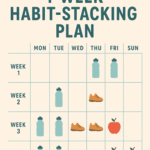It’s 3 p.m. and the urge hits you like a tidal wave. It’s not gentle hunger; it’s a specific, intense, and all-consuming demand for something sweet, salty, or rich. A cookie. A bag of chips. A slice of pizza. This is a food craving, and it can feel like a battle of willpower you’re destined to lose. But what if it’s not about willpower at all?
Food cravings are not a sign of personal weakness. They are a complex and powerful interplay of psychological and physiological signals rooted deep in our brain chemistry and hormonal responses. Understanding the science behind why you crave that cookie is the first step to outsmarting your brain and taking back control.
Your Brain on Sugar: The Dopamine Reward Loop
At the heart of most cravings is a powerful brain chemical called dopamine. Our brains have a reward system designed to encourage behaviors essential for survival, like eating. When you eat something highly palatable—particularly foods high in sugar, fat, and salt—your brain releases a flood of dopamine, creating a sensation of pleasure and reward.
This process is not unlike the way addictive substances work. The brain remembers this pleasurable experience and creates a strong neural pathway. The next time you see, smell, or even think about that food, your brain anticipates the reward and triggers the craving to get another dopamine hit. This is why a single taste can feel like it opens the floodgates, making it incredibly difficult to stop at just one.
The Physiological Triggers: Hormones and Health Habits
While dopamine sets the stage, several physiological factors can make you more susceptible to cravings.
- Stress: When you’re under stress, your body releases the hormone cortisol. Elevated cortisol levels can increase your appetite and your motivation to eat, especially for “comfort foods” that are high in sugar and fat. These foods provide a quick burst of energy and pleasure, temporarily soothing the stress response, but reinforcing the craving cycle.
- Lack of Sleep: A poor night’s sleep is one of the biggest drivers of intense cravings. Sleep deprivation disrupts the hormones that regulate your appetite. It causes levels of ghrelin (the “hunger hormone”) to rise, while levels of leptin (the “satiety hormone”) fall. This hormonal imbalance not only makes you feel hungrier but also specifically increases your desire for high-calorie, high-carbohydrate foods to get a quick energy fix.
- Hormonal Fluctuations: For many women, hormonal shifts throughout the menstrual cycle can significantly influence food cravings. Changes in estrogen and progesterone can affect levels of brain chemicals like serotonin, leading to cravings for carbs and sweets.
The Toolkit: 7 Evidence-Based Ways to Manage Cravings
Understanding the science is empowering, but having a practical toolkit is what creates real change. Instead of fighting your biology, you can work with it.
- Stay Hydrated: Thirst is often mistaken for hunger. Before you give in to a craving, drink a full glass of water and wait 15 minutes. This simple act can often satisfy the urge.
- Eat More Protein: Protein is the most satiating macronutrient. Including a source of lean protein with every meal helps stabilize blood sugar levels and keeps you feeling full and satisfied for longer, which is a powerful way to prevent cravings from starting in the first place.
- Don’t Starve Yourself: Skipping meals can cause your blood sugar to drop, leading to intense, almost primal cravings for a quick energy source (usually sugar). Eating regular, balanced meals helps keep your energy and hunger levels stable throughout the day.
- Prioritize Sleep: Aim for 7-9 hours of quality sleep per night. This is one of the most effective long-term strategies for regulating your hunger hormones and reducing the frequency and intensity of your cravings.
- Manage Your Stress: When a craving hits during a stressful moment, find a non-food coping mechanism. Go for a brisk walk, practice a few minutes of deep breathing, or listen to a favorite song. Exercise, in particular, releases endorphins that can effectively turn off a craving.
- Avoid Your Triggers: If you know that walking past a certain bakery every day triggers a craving, try taking a different route. If late-night TV is your cue for mindless snacking, try reading a book instead. Identifying and avoiding your personal triggers can break the habit loop.
- Talk it Out: Sometimes a craving is a call for comfort or distraction. Call a friend or family member to talk through what you’re feeling. A few words of encouragement or a simple distraction can be enough to let the craving pass.
Cravings are a normal part of the human experience. The goal isn’t to eliminate them forever, but to understand them. By recognizing the signals your brain and body are sending, you can respond with conscious, healthy choices that align with your goals, turning a moment of perceived weakness into an act of empowerment.




